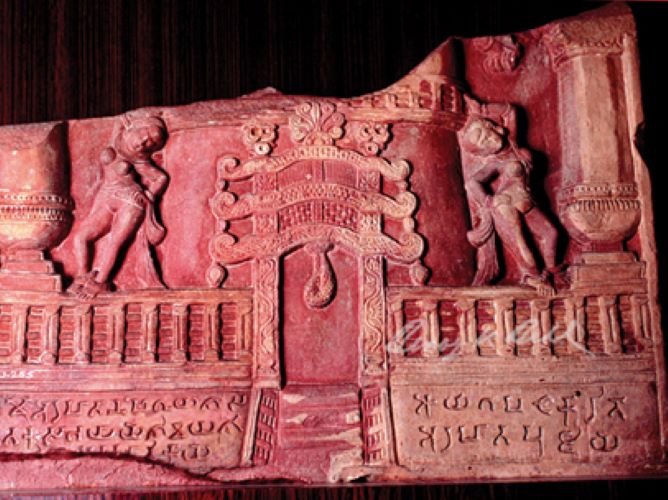Sunga dynasty & norms of Indian art

Depiction of gateway of Stupa, Jaina Stupa Railing, Kankali Tila, UP, 1st cent. BCE / 1st cent. CE. (Collection: Government Museum, Lucknow). Photo Credit: Benoy K Behl
Benoy K Behl
The rule of the Mauryas was followed by that of the Sunga Dynasty. About a hundred years, from 185 BCE till 73 BCE, is known as the Sunga period in Indian art. As their inscriptions show, the Sungas worshipped Hindu deities and were also benevolent to the Buddhist Sangha. The earliest body of Buddhist art, with images of the life of the Sakyamuni Buddha and Jataka stories of his previous births, was made under their rule. At least the first 700 years of surviving Buddhist art was all made under the rule of kings who worshipped Hindu deities. However, these kings gave equal attention and financial support to monuments dedicated to all the ancient spiritual streams.
Stupas are amongst the earliest Indian monuments which survive both of the Buddhist and Jaina traditions. Recent excavations near Nalanda have also unearthed a large mud stupa made between the eighth and the tenth centuries BCE. Early Chinese pilgrims mention that Indians created vast numbers of stupas, simply by piling up stones and bricks. It is a practice which continues in the Himalayan Buddhist regions in India till today. Just placing a few pebbles one on top of another, creates an object of worship. Divinity is present in the whole of creation, it is but for us to recognise it.
In Indic thought, the final truth which is sought is formless, arupa or nirguna (without qualities). The concept of the stupa (of Buddhist, Jaina and Ajivika worship) and the linga (or ‘symbol’ of the Hindu tradition) is explained in the Chitrasutra, the oldest-known treatise on art-making. It is mentioned in this treatise that, ‘The best way in which the eternal is to be imagined is without form. For seeing the true world, eyes are to be closed in meditation.’ Thus, a simple form, which does not remind us of men or women, animals, the fruits of the earth, or any of the shapes of the material world around us, is best to have before us when we wish to meditate upon the eternal.
Stupas or simple early lingas could be meditated upon, without reminding the devotee of any forms of the illusory world. The followers of Gautama Buddha enshrined his mortal remains in a number of stupas. Thus began a tradition which spread to many countries and continues till today. Stupas also housed mantras, the remains of other revered teachers and their personal belongings.
The great Borobudur stupa of the eighth-ninth century CE in Indonesia clearly illustrates the purpose of the stupa in Buddhist thought. The vast stupa has exquisite relief made around it, which one sees as one goes around the stupa. At the lowest level of circumambulation, we are presented the kamadhatu, the life of passions in the world. We then climb up the steps on the side of the edifice and the next two levels present us relief of the karmadhatu, or how we can improve our lot through good actions. The two levels above that present us the rupadhatu, the personification of enlightenment, through the life of Gautama Buddha. We see the Lalitvistara, the drama of the life of the Buddha. Here, we see scenes from his life and the Jataka stories. Finally, we go upward still, through the gateway of Kala, or Time. Leaving behind time itself, we approach the final truth, the arupadhatu, that which is without form. Here, at the final point of the ascent, it is the stupa itself which is before us.
Next on: Creation of early deities in Indian art.

